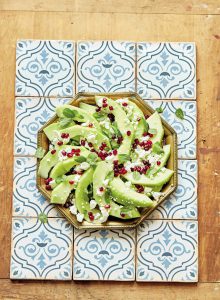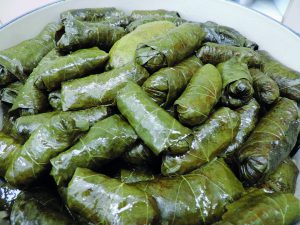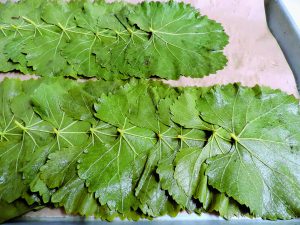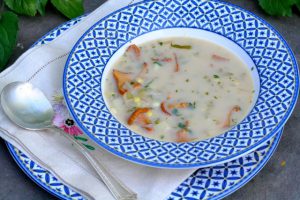Joy E. Stocke has been traveling to and writing about Turkey and the eastern Aegean since 1982. Her quest to discover the roots of Western religion has brought her to all of Turkey’s borders. Joy Stocke and Angie Brenner first met on the balcony of a guesthouse in a small resort town on the Mediterranean coast; they discovered a shared love of history, literature, and local food traditions. The two new friends set off on a cultural adventure tour of Turkey that spanned ten years. Returning home to their respective American kitchens, they couldn’t help but call upon the flavors of Anatolia as a kind of culinary souvenir and incorporate that sensibility into the food they cook every day for themselves, family, and friends.
The cookbook presents 100 recipes that weave Eastern ingredients and techniques with thoughtful adaptations of favorite authentic dishes. We have chosen to use recipes that we can easily gather ingredients here in the Capital Region for the most part. Certainly, we can’t gather the pomegranate needed for the Melon with Feta, Mint and Pomegranate dish but we certainly have tons of fresh mint to harvest, and the melons are great this year! Enjoy!

Carrot Hummus with Toasted Fennel Seeds
Ingredients
Makes 1½ cups (342 g)
3 large carrots, peeled and cut into chunks (about 2 cups)
1¼ teaspoons kosher salt
1 cup (236 ml) water
3 tablespoons yogurt
1 teaspoon fennel seeds
½ teaspoon flaky sea salt
Directions
This delicious, nourishing spread adapts the concept of hummus with familiar ingredients. It is based on yogurtlu havuç, a classic Turkish meze dip. Toasted fennel seeds and flaky sea salt add a bit of crunch. Serve the hummus with Classic Puffed Pide Bread or Stuffed Flatbread.
• Put the carrots in a medium heavy saucepan. Add the salt and 1 cup (236 ml) water.
• Bring to a boil over high heat, then reduce to a simmer, stirring occasionally. Cook for 10 minutes or until the carrots are very tender and the water is nearly evaporated. If the water evaporates before the carrots are fully cooked, add a little more.
• Remove from the heat and drain any water left in the pan.
• Add the yogurt to the carrots and blend with an immersion blender until smooth. (You can also use a food processor or blender.) The mixture should be creamy but not too thin. For a chunkier hummus, mash the carrot mixture in the pan with a fork.
• In a small frying pan over medium heat, combine the fennel seeds and sea salt. Toast until the seeds are fragrant and golden brown, about 5 minutes.
• Transfer the carrot hummus to a serving plate with a shallow rim. Sprinkle with the fennel salt before serving.

Melon with Feta, Mint and Pomegranate
Ingredients
Serves 4
1 ripe honeydew melon
4 ounces (75 g) crumbled feta cheese
½ cup (25 g) small fresh mint leaves
½ cup (75 g) pomegranate seeds
Directions
Sweet honeydew melon provides a juicy counterpoint to briny crumbles of feta in this colorful salad. Melon salads are often served as a meze with rakı; this one is also a good first course for a light lunch or supper.
• The most important thing is to use a ripe, fragrant melon.
• Slice the melon in half and scoop out the seeds.
• Cut the melon into 1-inch (25-mm) half-moon slices and remove the rind.
• Layer the melon slices on a serving tray, overlapping if necessary.
• Sprinkle the feta over the melon. Garnish with the mint and pomegranate seeds.


Stuffed Grape Leaves
Ingredients
Makes 30
For the filling
¼ cup (35 g) dried currants or raisins
3 tablespoons olive oil
2 medium onions, finely chopped
2 cloves garlic, minced
2 tablespoons pine nuts or shelled pistachio nuts
¾ teaspoon ground allspice
¾ teaspoon cinnamon
1 teaspoon chopped dill
¾ teaspoon Aleppo pepper
1 tablespoon finely chopped fresh mint (or dried mint)
1 teaspoon sugar
1 tablespoon tomato paste
1½ cups (270 g) basmati rice
½ teaspoon kosher salt
¼ teaspoon freshly ground black pepper
For rolling the sarma
30 grape leaves, fresh (see Preparing Fresh Grape Leaves, opposite) or store-bought
¾ cup (177 ml) olive oil
¼ cup (60 ml) lemon juice, or the juice from
1 medium lemon
Directions
• To blanch the leaves, bring a large pot of water to a rapid boil. Using tongs, drop 2 to 3 leaves into the pot at a time, and boil until soft and pliable. Young leaves in the spring will take only about 30 seconds. If the leaves are harvested in late summer or fall, they may take up to 1 minute.
• Carefully remove the leaves and lay them on a work surface, shiny side down, with the wide part of the base facing you.
• Put the currants in a small bowl. Cover with warm water and soak for 15 minutes, draining any leftover liquid.
• Heat the olive oil in a medium pot or large skillet over medium-low heat. Add the onions and garlic and cook for about 5 minutes until soft but not browned.
• Stir in the pine nuts, allspice, cinnamon, dill, Aleppo pepper, mint, sugar and tomato paste. Add the rice and ¾ cup (177 ml) water and bring the mixture to a boil.
• Turn the heat to low. Cover and simmer until the water is absorbed and the rice is still chewy, 10 to 15 minutes. (The rice will continue to cook inside the sarmas.)
• Remove the pot from the heat and add the salt and pepper, adjusting to taste. Stir in the currants, if using. Set the filling aside to cool. The filling can be made a day ahead and refrigerated.
• Put 1 teaspoon of filling at the base of the leaf.
• Carefully place the sarmas on the plate, seam-side down and very close together in one tight layer.
• Pour the olive oil then the lemon juice over the sarmas. Invert a second plate over them and press down gently. Pour in 2/3 cup (158 ml) water.
• Set the pot over medium-high heat and bring the water to a boil. Reduce the heat, cover and simmer the sarmas for 1 hour. Halfway through the cooking process, check to see if additional water is needed. The pot should not dry out.
• Let the sarmas cool for 15 minutes before carefully removing them from the pot to a serving plate.
The best way to pick grape leaves is to pick from wild vines. Nurtured vines for grapes from vineyards are not used for their leaves because they are not tender or tasty. The wild vines are perfect, devoting all of their energies to the leaves and never bearing fruit, so mother nature gets it rights again! The vines are not as a rule planted in the gardens but found along roads and walks, along fences and even parking areas. Wild grape leaves have three lobes and are jagged around the leaf. The vine itself is reddish, and the leaves are a brilliant green. Look for medium-sized leaves. They are tenderer than the larger leaves, but stronger than the very small leaves and will hold more stuffing. Pick at the base of the stem, where it attaches to the vine. Trim the stem off later. The stem protects the leaf from tearing when picked and gives the leaf more longevity. Only pick the perfect ones, without holes that make it impossible to stuff. Wash the leaves by rinsing them in cool water just before using them, then pat dry. We don’t usually blanch the leaves before rolling, but if the leaves are tough, they may need that, or soak in warm water to make pliable. If you are not using all the leaves right away or wish to store for the time of year that you can not find them here in the Capital Regions, store the leaves by freezing them, without washing them, in stacks wrapped well with plastic wrap, then in a heavy duty freezer bag. It is helpful to put those freezer bags into a hard compartment of some type like an old cereal box with the lid off, and that will protect from breaking or shattering before you use them. You want them big and without breakage or holes. If you are going to make stuffed grape leaves right away, you can simply store in the fridge. Frozen leaves last six months to a year in the freezer.

Chanterelle and Corn Chowder
Courtesy of Executive Chef Rob Handel from Heather Ridge Farm/Bees Knees Cafe
Ingredients
2 qts. chicken stock 4-5 ears of corn 2 bay leaves ¼ lb (4 oz) chanterelles, sliced 1 large onion, diced (approx. 1 cup) 2 cloves garlic, minced 2 ribs celery, diced (approx. ½ cup) 2 tablespoon butter 4 teaspoon salt ¼ cup white vermouth or white wine ½ lb waxy potatoes, diced (red skinned or Yukon golds are good choices) ½ teaspoon fresh ground black pepper 1 teaspoon fresh thyme, minced ¼ cup minced parsley ½ cup cream
Directions
Husk the corn and cut the kernels off the cob, taking care not to cut too far into the cob. If you cut too deep you’ll end up with the tougher ends of the kernels. Set the corn aside and cut the stripped cobs in half crosswise and add to a large saucepan with the stock. Add the bay leaves and bring to a simmer. Simmer for 30-45 minutes to extract the remaining corn flavor from the cobs. Strain and set aside. Meanwhile, melt the butter in another saucepan or soup pot and add the chanterelles, onion, garlic, and celery. Sauté over medium heat stirring frequently until the onions are translucent. Take care not to brown the onion or scorch the garlic. Add the vermouth and cook another minute, then add the stock, salt, and potatoes. Bring to a simmer and simmer for 15-30 minutes, until the potatoes are soft. Add the reserved cut corn and cook for another five minutes, then add the herbs, pepper, and cream. Taste and adjust salt and pepper to suit your tastes. Serve immediately, or chill and gently reheat. The soup will last for 4-6 days in the refrigerator. After chilling the cream may separate and cause the soup to look strange, simply stir it all together and it will be fine. See YouTube tutorials to help you through the process. And this recipe is a good choice for when those first few fillets don’t come out quite right. Give this fish a chance: the effort truly is worth it.
 Butternut Squash Spice Cake
Butternut Squash Spice Cake
Courtesy of Leah Stein from Leah’s Cakery
Ingredients
Cake 2 cups cake flour 1 cup whole-wheat pastry flour or sifted regular whole-wheat flour 1 teaspoon baking soda 1 teaspoon baking powder 1 teaspoon kosher salt 1 teaspoon cinnamon 2 teaspoons ground cardamom 1/2 teaspoon ground star anise (grind in a clean coffee grinder) or ground allspice 1 cup canola oil 2 large eggs 1 cup coconut palm sugar* or packed dark brown sugar 1/2 cup vanilla yogurt 1/2 cup orange juice 1/4 cup bourbon 1 tablespoon vanilla extract 1 tablespoon orange zest 1/3 cup chopped crystallized ginger 2 3/4 cups coarsely shredded butternut squash Frosting 3/4 cup salted butter, softened 12 ounces (1 1/2 large pkgs.) cream cheese, softened 3 cups powdered sugar 1 tablespoon bourbon 2 teaspoons ground cardamom 3/4 teaspoon kosher salt 3/4 teaspoon cinnamon 3/4 teaspoon ground ginger 1 cup toasted* unsweetened flaked (also called shaved) coconut
Directions
• Preheat oven to 350°. Grease 3 round cake pans (8 in. each). Line each with a circle of parchment paper and set aside.
• Mix cake flour, whole-wheat flour, baking soda, baking powder, salt, cinnamon, cardamom, and star anise in a large bowl; set aside.
• In bowl of a stand mixer fitted with paddle attachment, beat oil, eggs, coconut sugar, yogurt, orange juice, bourbon, and vanilla on medium speed until well blended. Add flour mixture; beat on low speed to blend, then on medium speed until smooth, scraping inside of bowl twice. Stir in orange zest and crystallized ginger, then squash.
• Divide batter among lined pans and spread level. Bake until a toothpick inserted in center comes out clean, 20 to 24 minutes.
• Turn cakes onto racks, remove parchment, and let cool completely, 1 to 1 1/2 hours.
• Make frosting: In bowl of a stand mixer fitted with paddle attachment, beat butter and cream cheese until very smooth. Add powdered sugar, bourbon, cardamom, salt, cinnamon, and ginger; beat on low speed to blend, then on high speed until smooth and fluffy, scraping inside of bowl once or twice.
• Set a cake layer rounded side down on a platter; spread top of it with 3/4 cup frosting. Repeat with second layer. Set top layer in place, rounded side up. Spread top and sides of cake with remaining frosting. Press coconut into sides, a small handful at a time.
• *Find coconut palm sugar in the baking aisle of well-stocked grocery stores. Toast coconut on a rimmed baking sheet in a 350° oven until light golden, stirring once, 4 to 5 minutes.
• Make ahead: Up to 1 day, chilled and loosely wrapped with plastic wrap.





